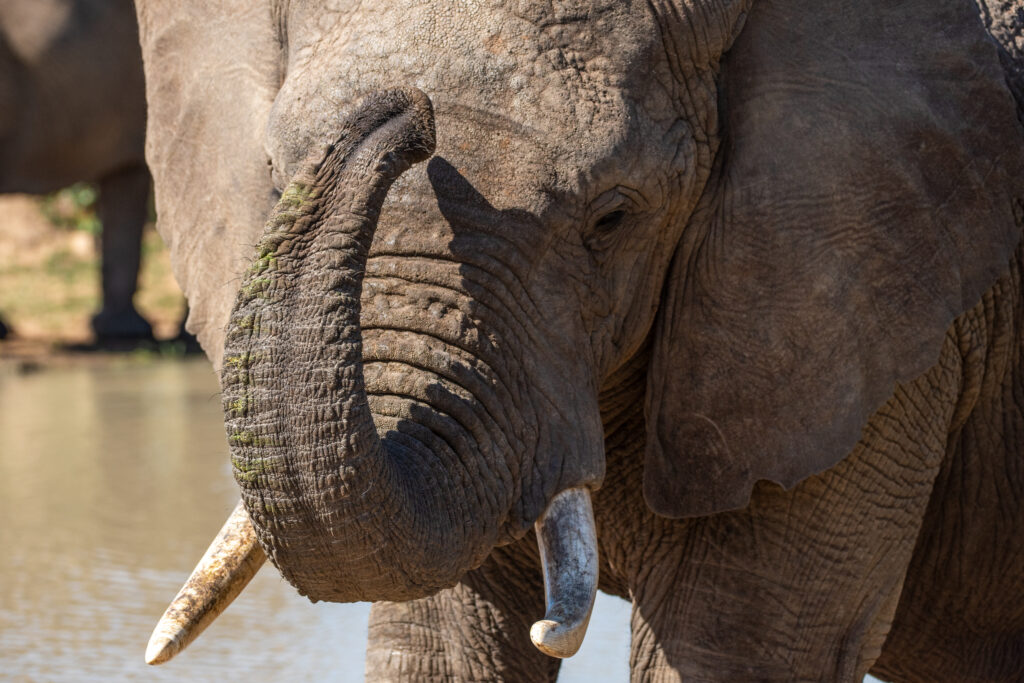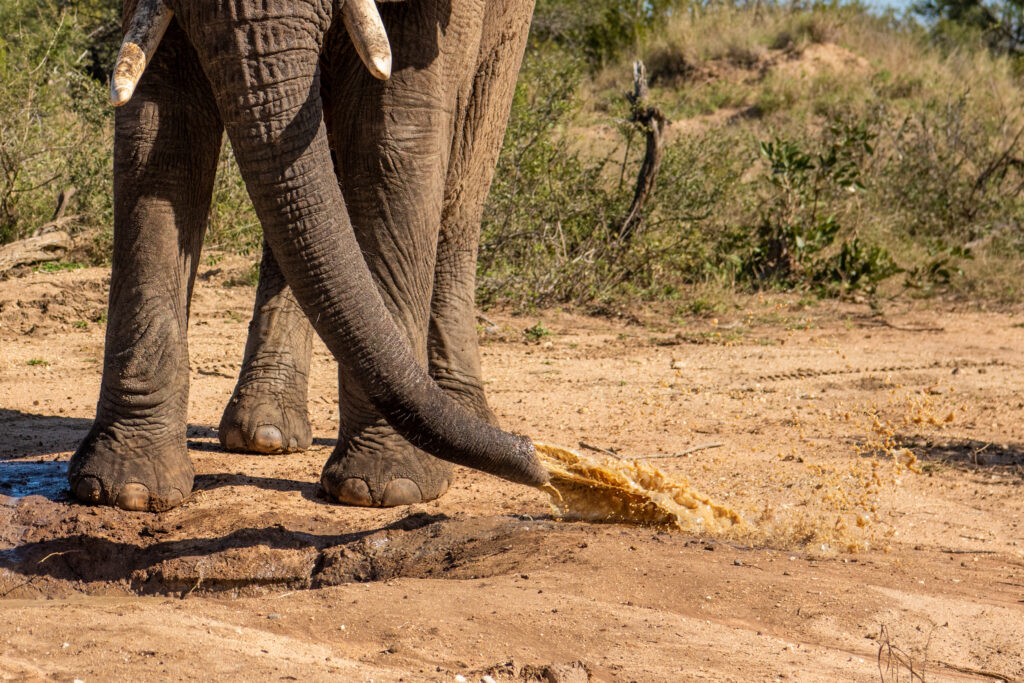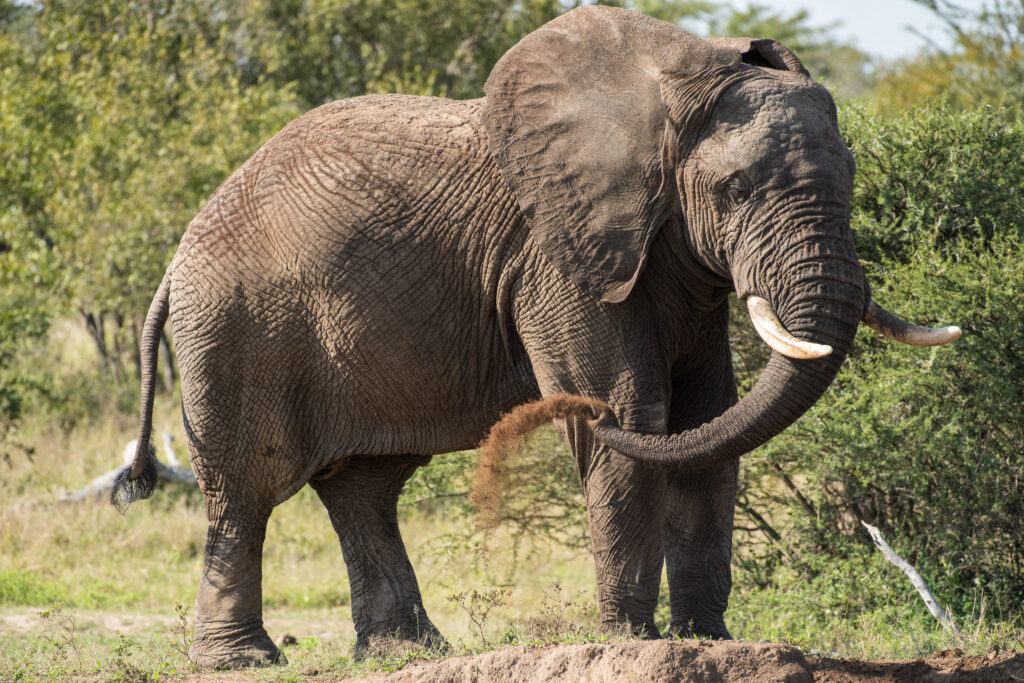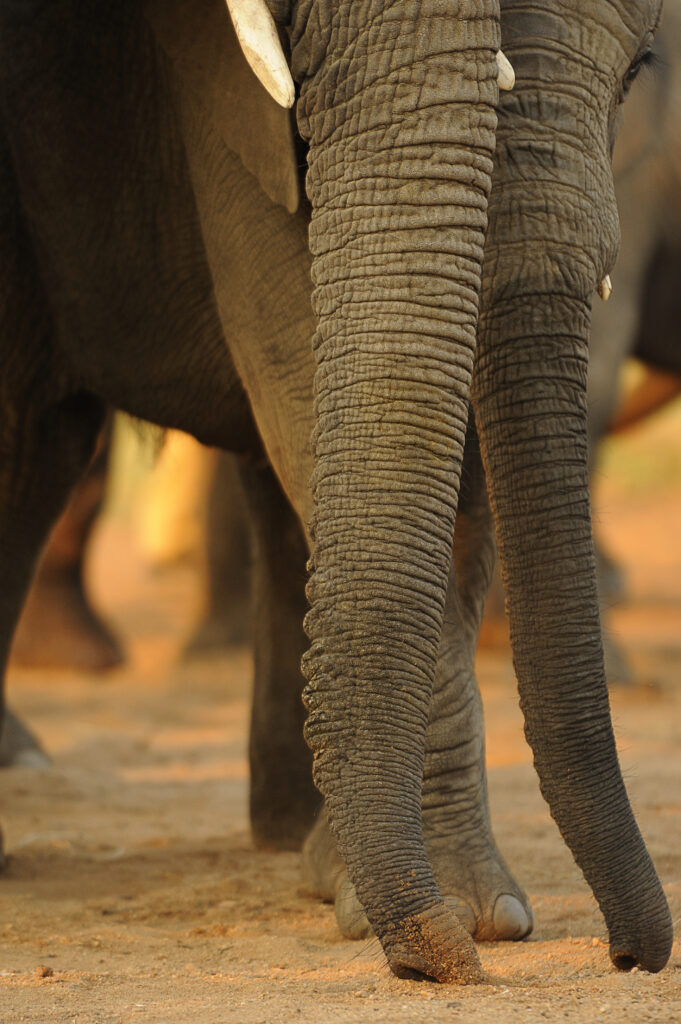Elephants are fascinating animals. Their bodies – their ears, their tusks, their feet – make them unique. One of their most interesting features is, of course, the trunk. Elephant trunks are capable of performing an astonishing range of complicated movements and tasks, from picking up small fruits to ripping trees from the ground. Strong and flexible, sensitive and complex, trunks form a vital part of elephants’ lives.
In this blog, we answer some of the questions we are often asked about elephant trunks. We look at the anatomy of the trunk, the functions of its various components, and how they work together to create one of the most versatile and powerful appendages in the animal kingdom.
How many muscles are there in an elephant’s trunk?
It’s a common misconception that there are hundreds of thousands of muscles in the trunk, but there are actually only 17 muscles in the trunk. There are eight muscles on each side of the trunk and one central muscle between the nasal passages.
The confusion regarding how many muscles there are in the trunk may be due to the fact that the 17 muscles of the trunk are composed of up to 150,000 muscle fascicles. Muscle fascicles are bundles of muscle fibres that are surrounded by connective tissue.
Are there any bones in an elephant’s trunk?
No, the trunk consists entirely of muscle. The muscles of the trunk are connected to the skull, but they are not supported by any bones. This type of muscular structure, in which muscles are only connected to bones on one end, is called a muscular hydrostat. In this way, it is similar to the tongue, or the tentacles of an octopus.

How do elephants move their trunks?
Elephants can move their trunks in a variety of different ways, due to the very complex muscular structure of the trunk. As we’ve mentioned, the trunk is a muscular hydrostat. A muscular hydrostat consists of a densely packed, three-dimensional collection of muscles. The muscles are arranged in three different directions, namely perpendicular to the long axis of the trunk, parallel to the long axis of the trunk, and helical or oblique around the long axis of the trunk. By contracting these different muscles, elephants can elongate, shorten, bend, stiffen, and twist their trunks. For example, elephants contract the helical and oblique muscles to twist their trunks.
In the same way that elephants tend to favour one tusk over the other, they also tend to only twist their trunks in one direction. This leads to more callusing on one side of the trunk. You can tell which twisting direction an elephant prefers by looking at which side of their trunk is stained green when they use their trunk to break vegetation.

Is the trunk like a nose? Do elephants breathe and smell with their trunks?
The trunk is an elongated combination of the upper lip and nose, and it therefore performs the functions of a nose. Elephants breathe through their trunks and smell with their trunks. Because of this, elephants can use their trunks as snorkels when the rest of their bodies are underwater.
The trunk has two nostrils. The nostrils are separated by a muscular septum, and they are separated throughout the entire trunk. The inside of the trunk is moist, and liquid is secreted to remove dust from the inside of the trunk.
Do elephants drink water through their trunks?
No, elephants don’t drink water through their trunks. If an elephant were to suck water too deeply into their trunks, the water would go to their lungs. Rather, elephants suck water up into their trunks, then squirt the water into their mouths. Adult elephants can hold 10 to 12 litres of water in their trunks. Very young elephants, who don’t have full use of their trunks yet, drink water with their mouths directly.
Very young elephants can’t use their trunks to suck up water, as they can’t use their trunks well and their trunks aren’t very strong. Instead, young calves use their mouths to suck up water. Calves need to learn how to use their trunks and complex manoeuvres can take time to learn. Their trunks grow stronger over time, as they grow older and start to use their trunks more frequently

Can elephants feel with their trunks?
Yes, the trunk is very sensitive to touch. The trunk is well-supplied with nerves and an exceptionally large portion of an elephant’s nervous system is associated with the trunk. There are sensory receptors throughout the trunk, such as the long sensory hairs that grow on the outside of the trunk.
The tip of the trunk, which consists of two finger-like structures in African elephants and one finger-like structure in Asian elephants, is especially sensitive, as it has a very complex nerve structure. There are three different types of sensory receptors in the trunk fingers:
• Free nerve endings
• Vellus vibrissae (tactile hairs)
• Pacinian corpuscles
These abundant and densely packed sensory receptors not only enable elephants to detect the shape, size, temperature, and texture of objects, but also enable elephants to detect vibrations.
Apart from smelling, breathing, drinking, and eating, what do elephants use their trunks for?
Elephants use their trunks to collect sand, soil, or mud. They then throw this onto their bodies to cover their skin, which helps to protect their skin against insects and the sun.
The trunk also helps elephants with various types of communication:
• Tactile communication: Elephants often touch one another with their trunks in order to communicate, such as when an elephant places their trunk in another elephant’s mouth to comfort them.
• Visual communication: Elephants use their trunks to send visual signals to one another, such as when an elephant swings their trunk in the direction of another elephant or a smaller animal in order to threaten them or scare them away.
• Acoustic communication: Elephants can force air through their trunks in various ways to create a wide variety of sounds, such as the powerful trumpets they produce when facing a threat.
• Chemical communication: Not only do elephants smell with their trunks to detect chemical signals, but they also use their trunks to collect substances and pass them to the Jacobson’s organ on the roof of the mouth. The chemical information is then analysed and conveyed to the brain.
• Seismic communication: Elephants use the tips of their trunks to detect vibrations, which enables them to detect sounds produced by other elephants over very long distances.

Sources
Carnaby, C. (2017) Beat About the Bush: Exploring the World – The Comprehensive Guide, Jacana Media.
Dagenais, P et al. (2021) Elephants evolved strategies reducing the biomechanical complexity of their trunk, Current Biology, 31, pp. 4727-4737. Available at: https://www.cell.com/action/showPdf?pii=S0960-9822%2821%2901133-7.
Kier, WM & Smith, KK. (1985) Tongues, tentacles and trunks: the biomechanics of movement in muscular-hydrostats, Zoological Journal of the Linnean Society, 83(4), pp. 307-324. Available at: https://people.duke.edu/~kksmith/papers/Kier_Smith_1985.pdf.
Poole, J & Granli, P. (2011) Signals, Gestures, and Behavior of African Elephants, The Amboseli Elephants: A Long-Term Perspective on a Long-Lived Mammal, Chapter 8. Available at: https://www.researchgate.net/publication/263654219_Signals_gestures_and_behaviors_of_African_elephants.
Purkart, L et al. (2022) Trigeminal ganglion and sensory nerves suggest tactile specialization of elephants, Current Biology, 32, pp. 904-910. Available at: https://www.cell.com/current-biology/pdf/S0960-9822(21)01738-3.pdf.
Rasmussen, LE & Munger, BL. (1996) The sensorineural specializations of the trunk tip (finger) of the Asian elephant, Elephas maximus, The Anatomical Record, 246(1), pp. 127-34. Available at: https://pubmed.ncbi.nlm.nih.gov/8876831/.
Sikes, SK. (1971) The Natural History of the African Elephant, American Elsevier.




 Comment
Comment








Thank you 🙏🏼
I heard elephants had 350 thousand muscle’s in their trunks🤪
Love watching the videos of these magnificent creatures 💚
It’s a common misconception that there are hundreds of thousands of muscles in the trunk, but there are actually only 17 muscles in the trunk.
In the Video “how an Elephant drinks”, at the 4:32 time stamp it is stated that “the Trunk alone contains abut 40 000 muscles”
There seems to be an obvious contradiction.
All the other information is very informative and much appreciated.
very educative